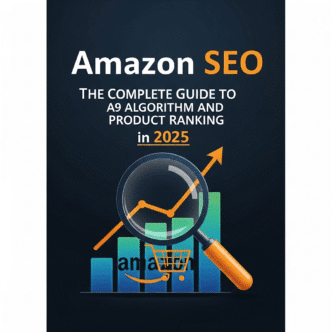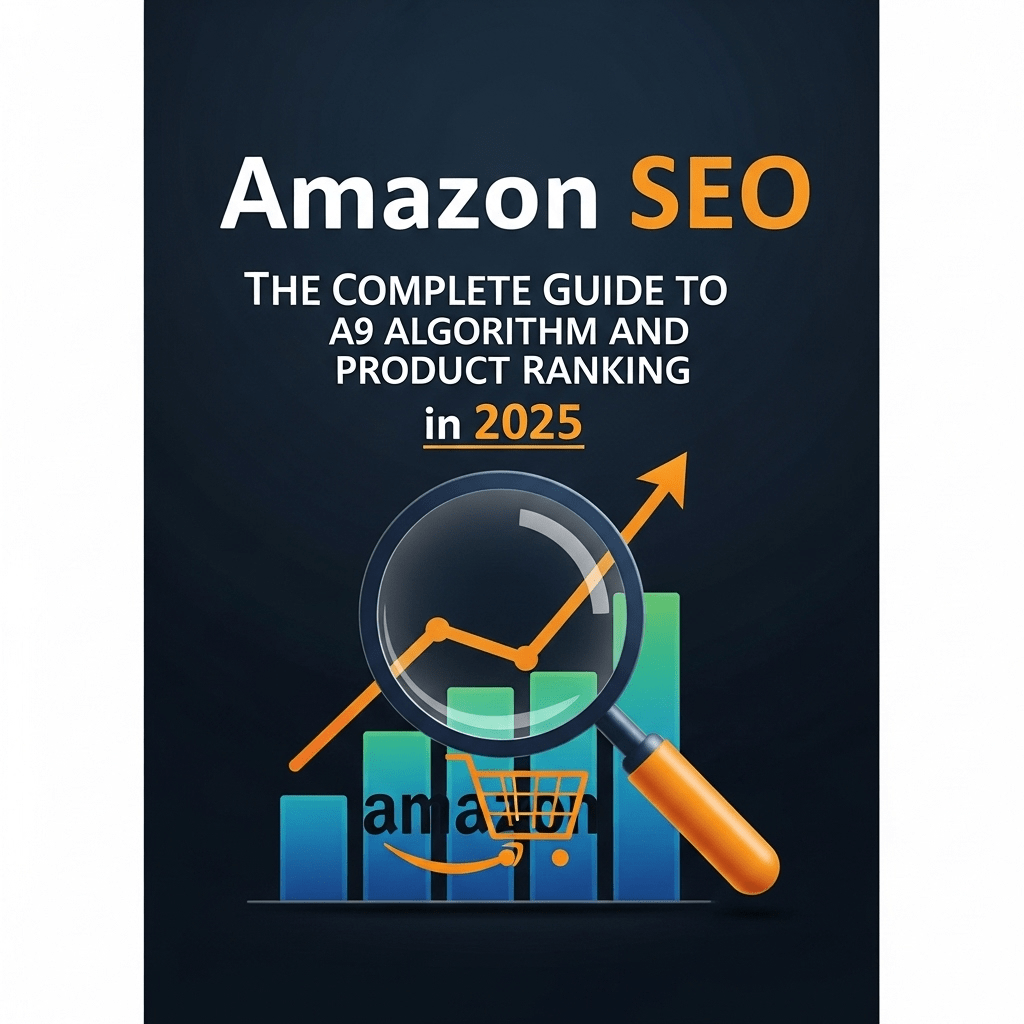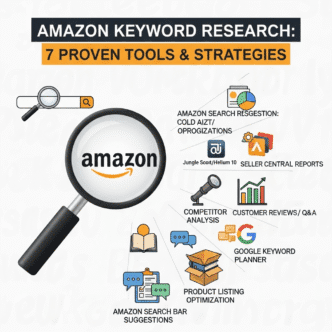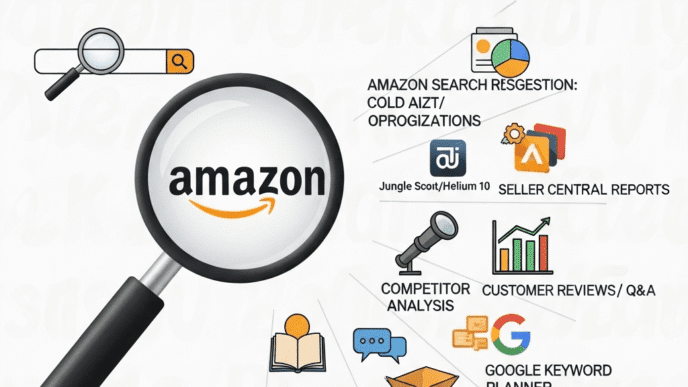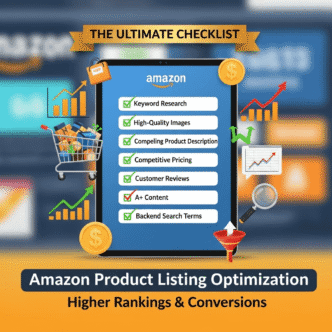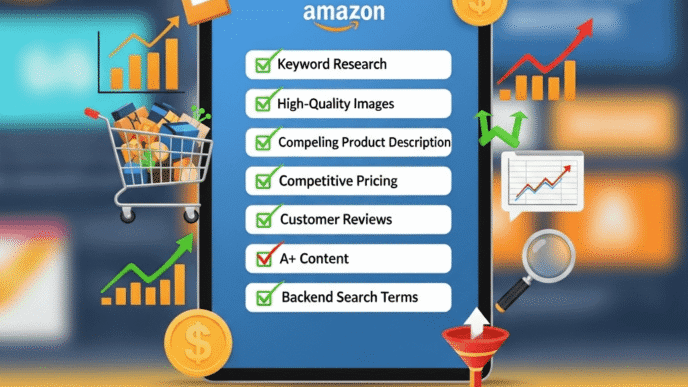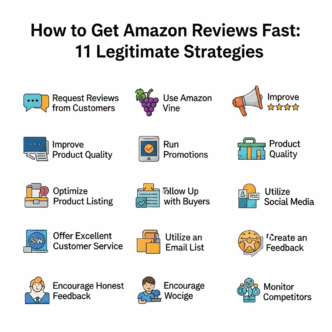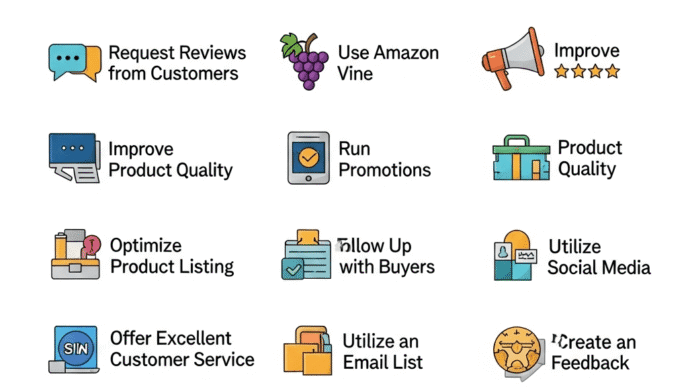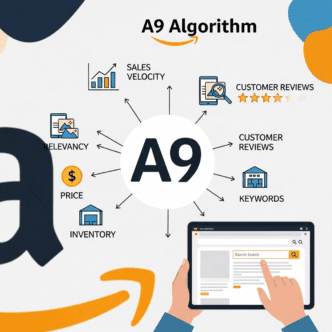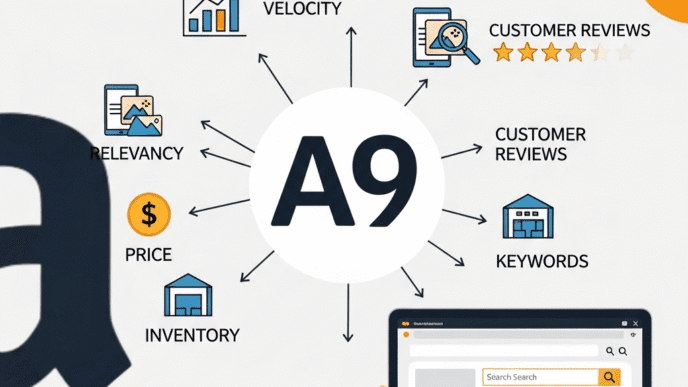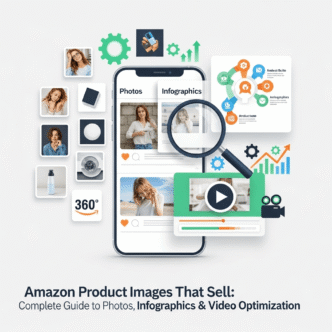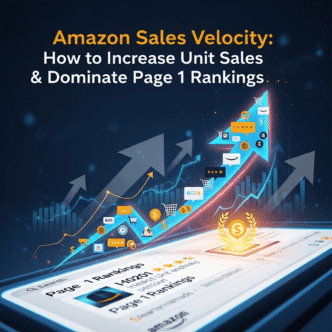You’ve got a killer product. Your margins are healthy. But your Amazon listing is buried on page 7, and the only person who sees it is your mom (bless her).
Sound familiar?
Here’s the brutal truth: Amazon SEO isn’t like Google SEO. It’s a completely different beast with its own rules, quirks, and secrets. While Google wants to show you the most relevant information, Amazon wants to show you products you’ll actually buy. That changes everything.
In this Amazon SEO guide, I’m going to walk you through exactly how Amazon’s A9 algorithm works, what it takes to rank your products in 2025, and the specific tactics that separate six-figure sellers from those still wondering why their listings aren’t converting.
No fluff. No outdated tactics. Just actionable strategies you can implement today.
Let’s dive in.
Table of Contents
ToggleWhat Is Amazon SEO and Why Should You Care?
Think of Amazon SEO as the art and science of making your products visible when customers search on Amazon.
Unlike traditional SEO where you’re optimizing for Google, Amazon SEO focuses on the A9 algorithm (now evolved into A10/A13 in 2025). This algorithm determines which products appear first when someone searches for “wireless headphones” or “organic dog treats.
Here’s why this matters: 70% of Amazon shoppers never scroll past the first page of search results. If you’re not ranking there, you’re essentially invisible.
The good news? Amazon wants you to succeed. When you sell, they make money. The algorithm isn’t your enemy—it’s just programmed to prioritize products that make Amazon the most profit while keeping customers happy.
Pro Tip: Amazon SEO is more forgiving than Google SEO. You can see results in days, not months. But you need to understand the rules of the game first.
How Does the Amazon A9 Algorithm Actually Work?
Let’s demystify this thing.
The A9 algorithm (and its newer iterations) has one primary goal: maximize revenue per customer. That means showing products that people are most likely to buy, not just click on.
The Three Pillars of Amazon’s Ranking Algorithm
Amazon evaluates your product based on three main factors:
1. Relevance – Does your product match what the customer is searching for?
2. Performance – Does your product convert when people land on it?
3. Customer Satisfaction – Do buyers love what they receive?
Think of it like a job interview. Relevance gets your resume past the screener. Performance gets you the interview. Customer satisfaction gets you the job (and keeps it).
Here’s the kicker: Amazon tracks everything. Your click-through rate, conversion rate, how long people stay on your page, whether they compare you to competitors, and even if they come back to buy your product later.
What Changed in 2025?
The algorithm has gotten smarter. Amazon now heavily weights:
- AI-powered customer intent matching (understanding what people really want)
- Post-purchase behavior (returns, reviews, repeat purchases)
- External traffic quality (bringing in customers from social media or ads that actually convert)
- Sustainability and Prime eligibility (eco-friendly products get subtle boosts)
The days of keyword stuffing are dead. Amazon can now understand synonyms, context, and even colloquial language. Searching for “headphones” might show you “earbuds” if that’s what people typically buy.
What Are the Most Important Amazon Ranking Factors?
Let me break down the factors that actually move the needle, ranked by impact.
1. Sales Velocity (The King Factor)
Sales velocity is how many units you sell in a given time period. This is the single most important ranking factor.
Amazon’s logic is simple: If 100 people search for “yoga mat” and 40% of them buy yours, you deserve to rank higher than the mat that only converts at 10%.
More sales = higher ranking = more visibility = more sales. It’s a beautiful (or vicious) cycle depending on which side you’re on.
2. Conversion Rate (The Queen Factor)
Your conversion rate tells Amazon: “When people see my listing, they buy.”
Amazon tracks this religiously. If 1,000 people view your product and only 5 buy, that’s a 0.5% conversion rate (ouch). Industry average is 10-15%.
Low conversion rates hurt your ranking and increase your ad costs. Amazon doesn’t want to waste valuable search real estate on products people won’t buy.
3. Relevance Score (Getting Found)
This determines if you even show up in search results. Your relevance score is based on:
- Backend keywords you’ve added
- Title, bullets, and description content
- Product category and attributes
- Customer search behavior (what words people use before buying your product)
Think of relevance as the bouncer at the club. You need to pass this test before performance even matters.
4. Price Competitiveness
Amazon loves a good deal. Not because they’re altruistic, but because competitive prices lead to more purchases.
If your product is significantly more expensive than similar items without justification (better reviews, Prime eligibility, brand recognition), you’ll struggle to rank.
Pro Tip: You don’t need to be the cheapest. You need to offer the best perceived value. A $45 product with 2,000 five-star reviews will outsell a $35 product with 50 mixed reviews.
5. Customer Reviews and Ratings
Reviews serve two purposes: social proof for buyers and ranking signals for Amazon.
The algorithm looks at:
- Overall rating (aim for 4.5+ stars)
- Number of reviews (more is better, but quality matters)
- Recent review velocity (getting new reviews consistently)
- Review content (mentions of keywords, product features)
Here’s something most sellers miss: negative reviews with seller responses often convert better than no reviews at all. It shows you care and builds trust.
6. Click-Through Rate (CTR)
When your product shows up in search, how often do people click on it?
Your CTR is influenced by:
- Main product image (this is HUGE)
- Title appeal
- Price display
- Prime badge
- Rating stars
- Best Seller badge (if you have it)
High CTR tells Amazon: “People want to learn more about this product.” Low CTR says: “This product doesn’t catch attention.”
7. Session Duration and Bounce Rate
Amazon tracks how long customers stay on your listing and what they do next.
Best case: They add to cart and buy.
Good case: They bookmark your product or visit multiple times before buying.
Bad case: They click your listing, leave after 3 seconds, and never come back.
The longer customers engage with your listing, the more valuable Amazon considers it.
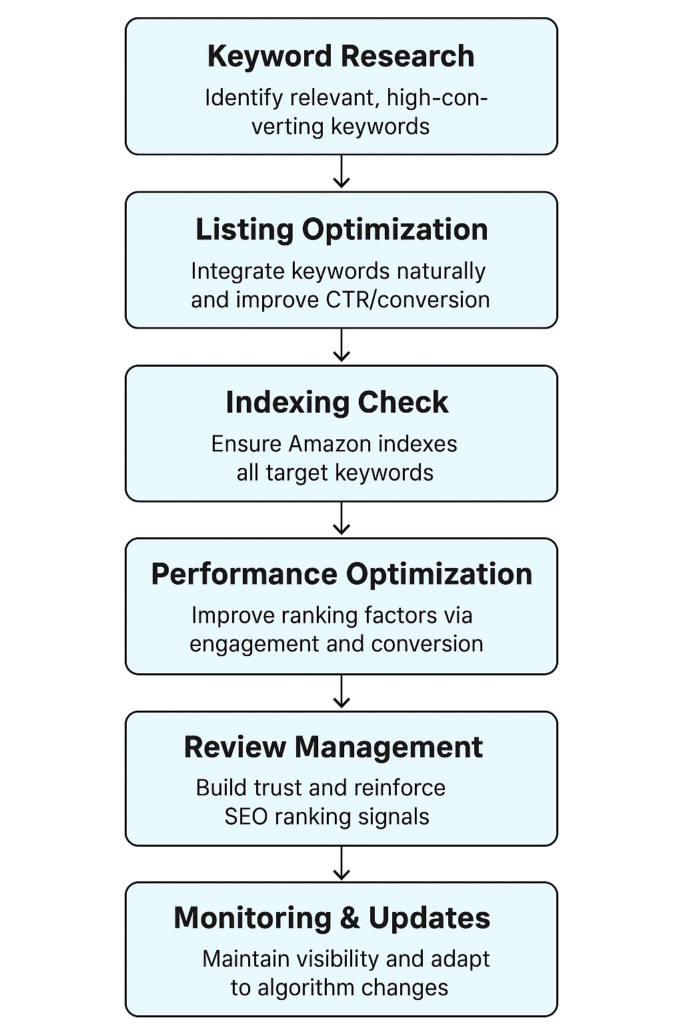
The Complete Amazon Keyword Research Strategy
Keywords are the foundation of Amazon product ranking. But here’s the twist: you’re not just optimizing for algorithms—you’re optimizing for buying intent.
How Amazon Keywords Differ from Google Keywords
On Google, people search for information: “how to tie a tie” or “best budget laptops 2025.
On Amazon, people search to buy: “men’s silk tie navy” or “laptop under $500.”
This means your keyword research for Amazon needs to focus on:
- Product-specific terms
- Brand names (including competitors)
- Problem-solving phrases (“back pain relief cushion”)
- Buying qualifiers (“best,” “affordable,” “professional-grade”)
Finding High-Converting Keywords: The 4-Step Process
Step 1: Start with Amazon’s Search Bar
Type your main product category into Amazon’s search bar. Don’t hit enter—just look at the auto-suggestions. These are real searches from real customers.
For example, type “wireless earbuds” and you’ll see:
- wireless earbuds noise cancelling
- wireless earbuds for small ears
- wireless earbuds waterproof
- wireless earbuds with long battery life
These suggestions are gold. They tell you exactly what customers want.
Step 2: Mine Your Competitors
Find the top 10 products in your category. Copy their titles, bullets, and descriptions into a document. Use a frequency counter tool to see which words appear most often.
The keywords your successful competitors use are proven to convert.
Step 3: Use Amazon Keyword Tools
Tools like Helium 10, Jungle Scout, or Cerebro can show you:
- Search volume for specific keywords
- Estimated monthly searches
- PPC cost per click
- Competing products for each keyword
Step 4: Organize by Intent and Priority
Not all keywords are equal. Organize yours into:
Primary Keywords (High volume, high relevance): “wireless earbuds,” “bluetooth headphones”
Secondary Keywords (Medium volume, more specific): “wireless earbuds for running,” “noise cancelling earbuds”
Long-tail Keywords (Lower volume, high conversion): “wireless earbuds for small ear canals women,” “sweatproof earbuds gym”
Use primary keywords in your title. Secondary keywords in bullets. Long-tail keywords throughout your description and backend fields.
The Backend Keyword Secret
Amazon gives you hidden fields called “backend keywords” or “search terms” that customers never see but the algorithm reads.
You get 249 bytes (not words, bytes) to add relevant keywords that didn’t fit naturally in your listing. Use this space wisely:
- Don’t repeat keywords already in your title/bullets
- Include common misspellings
- Add relevant synonyms
- Use spaces, not commas (saves characters)
- Don’t include brand names you don’t own
Pro Tip: Update your backend keywords every 60-90 days based on your Search Term Report from Amazon Advertising. This report shows exactly what customers searched before buying your product.
Optimizing Your Amazon Product Listing for Maximum Conversions
Your listing has one job: turn browsers into buyers. Let’s optimize every element.
Crafting the Perfect Amazon Product Title
Your title is prime real estate. It’s visible in search results, directly impacts CTR, and heavily influences ranking.
Amazon Title Formula for 2025:
[Brand Name] + [Product Line] + [Key Feature 1] + [Key Feature 2] + [Key Benefit] + [Size/Quantity/Color]
Example: “SOUNDMAX Pro Wireless Earbuds, Noise Cancelling Bluetooth 5.3 Headphones with 48H Playtime, IPX7 Waterproof Sport Earbuds with Charging Case, Black”
Title Best Practices:
- Keep it between 150-200 characters (mobile display)
- Front-load your primary keyword
- Include 2-3 key features/benefits
- Use correct capitalization (no ALL CAPS except acronyms)
- Make it readable, not just keyword-stuffed
- Include specifics (hours, measurements, materials)
Common Mistakes: ❌ Too short: “Wireless Earbuds” ❌ Keyword stuffing: “Earbuds Wireless Bluetooth Headphones Earphones Ear Buds Pods” ❌ Unclear: “Amazing Sound Quality Device”
Bullet Points That Actually Sell
Your bullets need to accomplish three things:
- Include important keywords naturally
- Address customer pain points
- Communicate clear benefits (not just features)
The Feature-Benefit Formula:
[FEATURE IN CAPS]: Benefit explanation that solves a problem or creates desire. Include specific details.
Example:
✓ 48-HOUR BATTERY LIFE: Never worry about charging mid-workout or during travel. Each earbud provides 8 hours of playtime, plus 40 additional hours from the compact charging case. Quick 10-minute charge gives you 2 hours of listening time.
✓ ACTIVE NOISE CANCELLATION: Block out 95% of ambient noise with advanced ANC technology. Perfect for focusing on work, enjoying music on flights, or drowning out noisy gym environments without cranking up the volume.
Notice how each bullet:
- Starts with a clear, capitalized feature
- Explains the benefit in everyday language
- Includes specific numbers and use cases
- Addresses a customer need
Pro Tip: Write your bullets in order of importance. Most customers only read the first 2-3 bullets. Put your strongest selling points first.
Product Images That Convert
Your main image is the single most important conversion factor. It determines whether someone clicks your listing in search results.
Main Image Requirements:
- Pure white background (RGB 255, 255, 255)
- Product fills 85% of frame
- Professional quality (minimum 1000px, recommend 2000px+)
- No text, logos, or graphics
- Shows product in use or context when allowed
Secondary Images Strategy:
Image 2: Product from different angle Image 3: Lifestyle shot (product being used) Image 4: Size/scale reference Image 5: Key features callout (with text) Image 6: Comparison or before/after Image 7: Package contents/what’s included
Image Optimization Tactics:
Use all 9 available image slots. More images = higher conversion rates.
Include infographic-style images that highlight features (for images 5-7, text is allowed).
Show your product next to common items for scale. Customers need to visualize actual size.
Test different main images using Amazon’s Manage Your Experiments feature.
Writing Product Descriptions That Convert
Most customers never read your description. But those who do are serious buyers doing research.
Your description should:
Tell a story about the customer’s journey with your product
Expand on bullet points with more detail and context
Include additional keywords naturally
Address common objections (sizing, compatibility, warranty)
Use formatting (short paragraphs, ALL CAPS for headers, spacing)
Example Structure:
[Introduction paragraph explaining who this product is for]
PREMIUM QUALITY CONSTRUCTION [Details about materials, manufacturing, testing]
DESIGNED FOR YOUR LIFESTYLE [Specific use cases and scenarios]
WHAT’S INCLUDED [Everything in the package]
OUR COMMITMENT TO YOU [Warranty, customer service, guarantees]
Pro Tip: Use HTML formatting if you’re in certain categories or have A+ Content access. Basic HTML (line breaks, bold, italic) can significantly improve readability.
A+ Content and Enhanced Brand Content: Are They Worth It?
If you’re brand registered (and you should be), A+ Content is a must-have.
What is A+ Content?
Enhanced visual content that appears in your product description area. It includes:
- High-quality lifestyle images
- Comparison charts
- Brand storytelling
- Feature callouts with graphics
Does A+ Content Help Amazon SEO?
Directly? No. A+ Content doesn’t contain indexable text for Amazon’s algorithm.
Indirectly? Absolutely. Here’s why:
Higher conversion rates (5-10% increase on average) signal quality to the algorithm
Lower bounce rates as customers stay on page longer
Better-informed buyers leave fewer negative reviews
Increased brand trust leads to repeat purchases
A+ Content Best Practices for 2025
Use the comparison chart module to position your product against competitors (without naming them).
Include lifestyle images showing real people using your product in context.
Focus on benefits, not features. Show customers how your product improves their life.
Keep it scannable. Use headers, short paragraphs, and visual hierarchy.
Update seasonally if relevant (showing summer use vs. winter use).
Amazon PPC: The Ranking Accelerator
Let’s be real: organic ranking takes time. Amazon PPC (Pay-Per-Click advertising) is how you accelerate the process.
How PPC Impacts Organic Ranking
Here’s the cycle:
PPC ads → More visibility → More clicks → More sales → Higher sales velocity → Better organic ranking → Less PPC needed
Amazon PPC doesn’t directly boost your organic ranking, but the sales from PPC absolutely do.
PPC Strategy for New Products
When launching a new product with no reviews or sales history, here’s your game plan:
Week 1-2: Automatic Campaigns
Let Amazon’s algorithm figure out which keywords convert for your product. Set aggressive bids to get data quickly.
Week 3-4: Manual Campaigns
Take the winning keywords from your auto campaign and create targeted manual campaigns. Add negative keywords to block irrelevant searches.
Week 5+: Optimization
Focus budget on your top 10 converting keywords. Lower bids on keywords with clicks but no sales.
PPC Campaign Types Explained
| Campaign Type | Best For | When to Use |
|---|---|---|
| Sponsored Products | Direct product promotion | Always (main strategy) |
| Sponsored Brands | Brand awareness + multiple products | Once you have 3+ products |
| Sponsored Display | Retargeting, competitor targeting | Mid to advanced stage |
| Video Ads | High-engagement product demos | Premium products or crowded niches |
Pro Tip: Most sellers waste money on broad match keywords. Start with “Phrase” and “Exact” match types, then expand to broad match only after you have proven winners.
Getting Your First Reviews (Without Breaking Amazon’s Rules)
Reviews are the chicken-and-egg problem of Amazon. You need reviews to get sales, but you need sales to get reviews.
What NOT to Do (Amazon’s Rules Are Strict)
❌ Don’t offer incentives for reviews (gift cards, refunds, discounts)
❌ Don’t ask family/friends to write reviews
❌ Don’t buy fake reviews from shady services
❌ Don’t offer “free product in exchange for review”
❌ Don’t manipulate review timing or content
Getting caught can get your account suspended permanently. It’s not worth it.
Legitimate Ways to Get Reviews in 2025
1. Amazon Vine Program
If you’re brand registered, this is the gold standard. Amazon invites trusted reviewers to try your product for free and leave honest reviews.
Cost: $200 per ASIN for up to 30 reviews. The reviews are marked as “Vine Customer Review” but carry full weight.
2. Request a Review Button
Amazon provides a built-in “Request a Review” button for every order. This sends customers a standardized message asking for feedback.
Best practice: Request review 5-7 days after delivery when product is fresh in their mind.
3. Amazon Early Reviewer Program (if available)
Amazon offers customers small incentives ($1-3) to review products with fewer than 5 reviews. You pay $60 per ASIN enrolled.
4. Product Inserts
Include a simple thank-you card in your packaging. Don’t directly ask for reviews, but you can:
- Thank them for their purchase
- Provide customer service contact info
- Offer a QR code to your website with setup guides
5. Email Campaigns Through Amazon
Use Amazon’s built-in buyer-seller messaging (not external email) to:
- Confirm order and thank customer
- Provide product tips and usage guides
- Ensure they’re satisfied with purchase
Pro Tip: Focus on providing such an amazing product and customer experience that reviews happen naturally. The best review strategy is having a product people genuinely love.
Inventory Management and the IPI Score
Here’s something most sellers ignore until it’s too late: your Inventory Performance Index (IPI) score directly impacts your ability to send inventory to Amazon and affects your ranking.
What Is the IPI Score?
Amazon rates your inventory management on a scale of 0-1000. You need at least 450 to avoid storage limits.
The IPI score measures:
- Excess inventory (products sitting too long)
- Stranded inventory (products not available for sale)
- In-stock rate (how often you’re available)
- Sell-through rate (how quickly you move inventory)
Why This Matters for SEO
Stockouts kill your ranking. When you go out of stock, Amazon essentially resets your organic ranking. You lose all momentum.
Even worse, Amazon deprioritizes products with frequent stockouts because they can’t rely on you to fulfill orders.
The Fix:
Use Amazon’s inventory planning tools to maintain 30-90 days of stock at all times.
Set up inventory alerts so you know when to reorder before running out.
Consider using FBA Inbound Placement Service to distribute inventory across multiple warehouses.
Advanced Amazon SEO Tactics for 2025
Ready to level up? These strategies separate top sellers from the rest.
1. External Traffic Campaigns
Amazon now rewards sellers who bring quality traffic from outside Amazon. They track this through:
- Amazon Attribution links
- Amazon Influencer Program
- Brand Referral Bonus (you get commission back for external traffic sales)
Where to drive external traffic:
- Instagram/TikTok with product reviews
- YouTube unboxing videos
- Pinterest for visual products
- Facebook groups in your niche
- Email lists (if you have one)
The key word is quality. Traffic that converts gets rewarded. Traffic that bounces hurts you.
2. Subscribe & Save Optimization
Products eligible for Subscribe & Save get a ranking boost and appear in dedicated search filters.
Requirements:
- Must be a consumable or regularly used item
- Enrolled in FBA
- Price stability (no drastic fluctuations)
Benefits:
- Predictable recurring revenue
- Higher customer lifetime value
- Improved organic ranking
- Protected against competitors (customers are “locked in”)
3. Amazon Posts (Social Commerce)
Think of Amazon Posts as Instagram inside Amazon. Customers can discover your products through lifestyle images in a social feed.
These posts:
- Don’t directly impact SEO rankings
- Increase brand visibility and consideration
- Drive traffic to your listings (which improves sales velocity)
- Are completely free to create
Create 3-5 posts per week showing your products in real-life scenarios.
4. Strategic Product Bundling
Creating product bundles can help you:
- Compete in crowded categories with unique offerings
- Increase average order value
- Target long-tail keyword combinations
- Reduce competition (your bundle is unique)
Example: Instead of selling just a yoga mat, bundle it with a yoga strap and blocks. Now you’re targeting “yoga mat set” instead of competing with 50,000 other mats.
5. Seasonal Optimization
Smart sellers adjust their listings for seasonal trends:
Q4 (Holiday Season):
- Update images to show gift-giving scenarios
- Add “gift” related keywords to title/bullets
- Emphasize fast shipping and Prime eligibility
- Create holiday-themed A+ Content
Summer/Winter:
- Adjust main images to show seasonal usage
- Update bullets to highlight season-specific benefits
- Modify backend keywords for seasonal searches
6. International Expansion
Amazon operates in multiple countries. Your Amazon SEO guide should include international opportunities:
- UK, Germany, France, Italy, Spain (EU)
- Canada
- Mexico
- Japan
- Australia
- India
The same product that ranks on page 5 in the US might dominate page 1 in Canada or Australia due to less competition.
Use Amazon’s Global Selling program to expand with minimal additional effort.
Common Amazon SEO Mistakes That Kill Rankings
Let’s talk about what not to do.
Mistake 1: Keyword Stuffing in Titles
Bad Title: “Wireless Earbuds Bluetooth Headphones Earphones Ear Buds Pods Noise Cancelling Waterproof Sport Gaming Music Running Gym Workout iPhone Android”
This looks spammy, hurts CTR, and Amazon’s algorithm now penalizes obvious keyword stuffing.
Good Title: “SOUNDMAX Pro Wireless Earbuds, Noise Cancelling Bluetooth 5.3 Headphones with 48H Playtime, IPX7 Waterproof”
Mistake 2: Ignoring Mobile Optimization
65% of Amazon purchases happen on mobile devices. If your listing isn’t mobile-friendly, you’re leaving money on the table.
Mobile-specific issues:
- Titles that get cut off (optimize for 80-100 characters visible on mobile)
- Images that don’t zoom well or show detail
- Bullets that are too long (first 2-3 are crucial)
- Videos that don’t play or load slowly
Test your listing on mobile before launching.
Mistake 3: Copying Competitor Listings Exactly
Seems smart, right? Just copy what’s working for the #1 ranked product?
Wrong. Here’s why:
Amazon values uniqueness and diversity. Duplicate content gets flagged.
You have different strengths and weaknesses than your competitor.
You have no way to differentiate yourself and become “just another option.”
Learn from competitors, but create original content that highlights your unique value proposition.
Mistake 4: Neglecting Customer Questions
The Q&A section on your listing is an SEO goldmine that most sellers ignore.
When customers ask questions:
- Answer them quickly and thoroughly
- Include relevant keywords naturally in answers
- This content is indexed by Amazon’s search algorithm
- Future customers see your helpfulness (social proof)
Proactively add Q&As for common questions. You can ask questions yourself (from a separate account) and answer them as the seller.
Mistake 5: Set It and Forget It
Your listing needs ongoing optimization. Top sellers review their metrics weekly:
- Search term reports (what keywords are converting?)
- Click-through rates (is my main image working?)
- Conversion rates (where are customers dropping off?)
- Competitor changes (did they improve their listing?)
- Seasonal trends (do I need to adjust messaging?)
Schedule monthly reviews of your entire listing and make data-driven improvements.
Tools Every Amazon Seller Needs for SEO Success
You can’t optimize what you don’t measure. Here are the essential Amazon SEO tools for 2025:
| Tool | Best For | Price Range |
|---|---|---|
| Helium 10 | All-in-one keyword research, listing optimization, PPC | $29-$279/month |
| Jungle Scout | Product research, keyword tracking, competitor analysis | $29-$129/month |
| Cerebro (by Helium 10) | Reverse ASIN lookup, competitor keyword research | Included in Helium 10 |
| AMZScout | Product database, keyword tracking, Chrome extension | $20-$70/month |
| Keepa | Price tracking, sales rank history, deal alerts | Free + $19/month premium |
| SellerApp | Automated PPC optimization, listing quality score | $99-$299/month |
| ManageByStats | Analytics dashboard, inventory alerts, PPC management | $19-$99/month |
Pro Tip: Start with Helium 10’s free plan to learn the basics. Upgrade only when you’re consistently making sales and need advanced features.
Free Amazon SEO Tools
Not ready to invest yet? Use these free options:
Amazon’s Search Bar: Best free keyword research tool available
Sonar by Sellics: Free keyword database and reverse ASIN tool
Google Keyword Planner: Shows search trends (not Amazon-specific but useful)
Keepa (Basic): Track price history and sales rank for any ASIN
Amazon Brand Analytics: Free for brand-registered sellers (shows top search terms)
Tracking Your Amazon SEO Performance
You can’t improve what you don’t measure. Here’s exactly what to track.
Essential Metrics Dashboard
Organic Ranking Position: Track where you rank for your top 10 keywords weekly
Sales Velocity: Total units sold per day/week/month
Conversion Rate: Percentage of visits that result in sales (aim for 10-15%)
Session Percentage: Your product’s share of total category sessions
Click-Through Rate: Impressions vs. clicks (aim for 0.5%+ in competitive categories)
Unit Session Percentage: Orders divided by sessions (this is your conversion rate)
Buy Box Percentage: How often you win the Buy Box (aim for 95%+)
Return Rate: Keep this under 5% (high returns hurt ranking)
Where to Find This Data
Amazon Seller Central Dashboard:
- Business Reports section
- Brand Analytics (if brand registered)
- Advertising Console
Third-Party Tools:
- Helium 10’s Keyword Tracker
- Jungle Scout’s Rank Tracker
- Sellics dashboard
Set up a simple spreadsheet or dashboard and update it weekly. Look for trends, not daily fluctuations.
Pro Tip: Track your top 3 competitors’ rankings alongside yours. When they jump in ranking, investigate what changed. Learn from their tactics.
Real-World Amazon SEO Case Study
Let me share a real example of how proper Amazon SEO strategy transformed a struggling listing.
The Product: Bamboo Cutting Board
Starting Position:
- Ranking: Page 4 for “cutting board”
- Sales: 5-8 units per day
- Reviews: 47 reviews, 4.3-star average
- Conversion Rate: 7%
What We Fixed:
Title Optimization:
- Before: “Bamboo Cutting Board”
- After: “Large Bamboo Cutting Board with Juice Groove, 18×12 Inch Wood Cutting Board for Kitchen, Extra Thick Chopping Board for Meat & Vegetables”
Added specific dimensions, use cases, and key features.
Image Overhaul:
- Replaced amateur photos with professional lifestyle images
- Added infographic highlighting “extra thick” and “juice groove” features
- Included size comparison with common kitchen items
- Created lifestyle shot showing board in use with fresh ingredients
Bullet Points:
- Rewrote using Feature-Benefit formula
- Added keywords like “large cutting board,” “wooden cutting board,” “kitchen cutting board”
- Addressed common objections (maintenance, durability, food safety)
Backend Keywords:
- Added variations: “chopping board,” “butcher block,” “prep board”
- Included material-specific terms: “bamboo board,” “wood board”
- Added problem-solving phrases: “cutting board won’t slip,” “easy clean cutting board”
PPC Launch:
- Started aggressive auto campaign for 2 weeks
- Identified “bamboo cutting board large” as highest converter
- Focused 70% of budget on top 5 performing keywords
The Results After 60 Days:
✓ Ranking: Page 1, position 8 for “cutting board” (main keyword) ✓ Sales: 35-45 units per day ✓ Reviews: 127 reviews, 4.7-star average (improved through product inserts with customer service info) ✓ Conversion Rate: 14% ✓ Total Revenue Increase: 4.8x
Key Takeaway: The product didn’t change. The messaging, positioning, and optimization made all the difference.
Future of Amazon SEO: What’s Coming in 2025 and Beyond
The Amazon algorithm never stops evolving. Here’s what to prepare for:
1. AI-Powered Search Understanding
Amazon is implementing advanced natural language processing (NLP). Customers can search in full sentences: “noise cancelling headphones good for airplane travel under $100”
Your listing needs to address these conversational queries naturally, not just hit individual keywords.
2. Visual Search Expansion
Amazon’s visual search feature lets customers take a photo and find similar products. Optimizing for visual search means:
- High-quality, diverse product images
- Accurate categorization
- Detailed product attributes
3. Voice Commerce Integration
“Alexa, reorder my coffee pods” is becoming standard. Voice search optimization requires:
- Natural language in product titles
- Brand name pronunciation clarity
- Strong brand recognition
- High repeat purchase rate
4. Sustainability Badges
Amazon is rolling out “Climate Pledge Friendly” badges more prominently. Products with eco-friendly certifications get visibility boosts.
Consider: recyclable packaging, carbon-neutral shipping, sustainable materials.
5. Personalization Algorithms
Amazon is personalizing search results based on individual browsing history, purchase patterns, and preferences.
This means: consistent performance matters more than ever. You need to convert all types of customers, not just your ideal buyer.
Your 30-Day Amazon SEO Action Plan
Ready to implement everything? Here’s your step-by-step roadmap.
Week 1: Research & Analysis
Day 1-2: Complete keyword research using Amazon search bar and one paid tool
Day 3-4: Analyze top 10 competitors in your category (titles, bullets, images, pricing)
Day 5-7: Audit your current listing against best practices and create optimization plan
Week 2: Listing Optimization
Day 8-9: Rewrite title and bullet points using keyword research
Day 10-12: Upgrade product images (hire photographer if needed, minimum 5 quality images)
Day 13-14: Rewrite product description and update backend keywords
Week 3: Launch & Promotion
Day 15-16: Launch PPC campaigns (auto and manual targeting top keywords)
Day 17-18: Enroll in Amazon Vine if eligible, or start review request campaign
Day 19-21: Create and schedule Amazon Posts for social visibility
Week 4: Monitoring & Adjustment
Day 22-24: Analyze PPC performance, adjust bids and add negative keywords
Day 25-27: Track ranking changes for top keywords, identify what’s working
Day 28-30: Make data-driven tweaks to listing based on first 3 weeks of performance
Pro Tip: Don’t change everything at once. Make one major change per week so you can isolate what’s actually moving the needle.
FAQs About Amazon SEO
Q: How long does it take to see results from Amazon SEO?
Unlike Google SEO which can take 3-6 months, Amazon SEO is much faster. You’ll typically see ranking changes within 1-2 weeks of optimization, especially if you’re also running PPC to boost sales velocity. Full results usually manifest within 30-60 days.
Q: Can I rank without Amazon PPC?
Yes, but it’s much slower. PPC accelerates the process by generating initial sales that signal to Amazon your product is worth ranking. For competitive categories, PPC is essentially mandatory to get started. Once you have organic momentum, you can reduce PPC spend.
Q: How often should I update my Amazon listing?
Review your listing monthly for minor tweaks based on performance data. Do a major optimization quarterly or whenever you see significant ranking drops.
Q: What’s more important: keyword optimization or product images?
Both matter, but they serve different stages. Keywords get you found in search results. Images get you clicked and converted. Without proper keywords, your amazing images won’t be seen. Without great images, your keyword optimization won’t convert. Prioritize keywords first to get visibility, then optimize images to maximize that visibility.
Q: Should I use the same keywords as my competitors?
Use them as a starting point, but don’t copy exactly. Identify the keywords your competitors rank for, then find gaps they’re missing. Look for long-tail keywords where competition is lower but buying intent is high. Differentiate by targeting specific customer pain points your competitors ignore.
Q: How many keywords should I target in my listing?
Focus on 1 primary keyword, 3-5 secondary keywords in your title and bullets, and 10-20 long-tail keywords throughout your description and backend fields. Quality over quantity—better to rank well for 10 relevant keywords than poorly for 100 irrelevant ones.
Q: Does changing my product price affect my ranking?
Yes, significantly. Frequent or drastic price changes can hurt your ranking because they disrupt your sales velocity pattern. If you must adjust pricing, do it gradually. Amazon’s algorithm also considers your price competitiveness relative to similar products. Being significantly overpriced will hurt your conversion rate, which hurts ranking.
Q: Will negative reviews kill my Amazon SEO?
Not immediately, but they hurt conversion rates, which eventually impacts ranking. A few negative reviews among hundreds of positive ones won’t destroy you. Focus on responding professionally to negative reviews and solving customer problems quickly. What really kills rankings is a sudden influx of negative reviews indicating product quality issues.
Q: Can I optimize multiple products for the same keyword?
You can, but you’ll be competing with yourself. Amazon will typically favor your better-performing product for that keyword. Strategy: use slight variations of the same keyword across products, or bundle products differently to target unique keyword combinations.
Q: Is Amazon SEO different for FBA vs. FBM (Fulfilled by Merchant)?
The core principles are the same, but FBA products get a significant advantage. They’re eligible for Prime, which Amazon strongly favors in rankings. FBA products also typically have faster shipping, better return processes, and higher customer trust—all factors that improve conversion rates and rankings.
The Hidden Amazon SEO Factors Nobody Talks About
Beyond the obvious tactics, these under-the-radar factors can give you an edge.
Account Health and Performance Metrics
Your overall Amazon seller account health impacts individual product rankings.
Amazon tracks:
Order Defect Rate (ODR): Keep below 1%. This includes negative feedback, A-to-Z claims, and chargebacks.
Late Shipment Rate: Keep below 4% (mainly for FBM sellers).
Pre-Fulfillment Cancel Rate: Keep below 2.5%. Canceling orders signals inventory problems.
Valid Tracking Rate: Maintain above 95% (shows shipping reliability).
A healthy account gives all your listings a small ranking boost. A problematic account can suppress even well-optimized listings.
Pro Tip: Set up alerts in Seller Central to notify you immediately if any metric approaches warning thresholds. Prevention is easier than recovery.
Product Listing Completeness Score
Amazon has an internal “completeness score” for every listing that affects ranking. Higher completeness = better ranking potential.
Factors that improve completeness:
✓ All image slots filled (9 maximum) ✓ A+ Content or Enhanced Brand Content added ✓ Video content uploaded ✓ Complete product attributes (size, color, material, etc.) ✓ Detailed product dimensions and weight ✓ Product variations fully built out ✓ Backend search terms filled ✓ All relevant compliance documents uploaded
Many sellers leave these fields incomplete. Easy competitive advantage.
Amazon Brand Registry Benefits
If you haven’t registered your brand, you’re leaving major advantages on the table:
Enhanced Brand Content / A+ Content: Visual storytelling that increases conversions
Brand Analytics: Access to search term reports showing exactly what customers search
Sponsored Brands Ads: Headline ads that dominate search results
Amazon Vine: Early reviewer program for new products
Brand Store: Free multi-page storefront on Amazon
Project Zero: Automated protection against counterfeiters
Video in Image Gallery: Add videos to your main product gallery
Registration costs nothing and takes 1-2 weeks. If you have a trademark, do this immediately.
The Power of Product Variations
Creating product variations (also called parent-child relationships) is an advanced tactic that consolidates ranking power.
Example: Instead of separate listings for:
- Blue yoga mat
- Purple yoga mat
- Pink yoga mat
Create one parent listing with three child variations. Benefits:
Shared review count: All color variations share the same review pool
Consolidated ranking power: Sales from all variations boost the parent listing
Better customer experience: Customers can switch colors without leaving the page
Higher perceived popularity: “Available in 3 colors” signals variety and demand
Pro Tip: Only use variations for true variants of the same product (color, size, pack quantity). Don’t bundle unrelated products as variations—Amazon will flag this as abuse.
Geographic and Seasonal Ranking Fluctuations
Here’s something weird: your product might rank differently based on the customer’s location.
Amazon personalizes search results based on:
Customer location: Products in nearby warehouses get priority for faster delivery
Local demand patterns: What’s popular in Texas might differ from New York
Seasonal relevance: Winter products naturally rank better in northern states during cold months
Prime availability: Your Prime eligibility varies by fulfillment center inventory
What this means for you: Distribute inventory across multiple Amazon warehouses for broader geographic reach. Use Amazon’s Inbound Placement Service to ensure coverage.
Amazon SEO for International Markets
Expanding internationally can 10x your business. Here’s how Amazon SEO differs across regions.
Key Differences by Marketplace
United Kingdom, Germany, France, Italy, Spain (European Marketplaces):
- Language optimization matters: Don’t just translate—localize. Hire native speakers.
- VAT requirements: Tax compliance affects Buy Box eligibility
- Cultural preferences: Product features valued differently (Germans love detailed specs)
- Currency display: Price perception varies by currency
Japan:
- Extreme attention to detail: Listings need extensive product information
- Packaging matters: Japanese customers value presentation
- Customer service expectations: Very high standards for communication
- Size specifications: Must be incredibly accurate
Canada:
- Bilingual optimization: French language requirements for certain products
- Less competition: Many US sellers skip Canada (opportunity!)
- Similar behavior to US: Buying patterns closely mirror American market
Australia:
- Growing market: Less saturated than US/Europe
- Shipping considerations: Distance from warehouses affects delivery promises
- Price sensitivity: Australians expect higher prices (import costs)
International Expansion Strategy
Phase 1: Start with English-speaking markets (UK, Canada, Australia)
Phase 2: Expand to European markets (Germany has highest buying power)
Phase 3: Consider Japan for products with quality/detail focus
Use Amazon’s Global Selling program to manage multiple marketplaces from one account. Enable Amazon Global Logistics for simplified international shipping.
Pro Tip: Your US reviews don’t transfer to international marketplaces. Plan to launch international listings with Amazon Vine or early reviewer programs to overcome the “zero review” problem.
Category-Specific Amazon SEO Strategies
Different categories require different approaches. Here’s how to optimize by category.
Fashion & Apparel
Unique challenges: Size and fit issues, high return rates, seasonal trends
SEO Focus:
- Extremely detailed size charts (reduce returns)
- Multiple models showing fit on different body types
- Material and care instructions (washing, fabric content)
- Style and occasion keywords (“summer dress,” “business casual shirt”)
- Color accuracy in images (lighting matters)
Pro Tip: Include a size comparison chart in your images. “Model is 5’7″ and wearing size Medium” reduces returns and improves conversion rates.
Electronics & Accessories
Unique challenges: Technical specifications, compatibility issues, rapid innovation
SEO Focus:
- Compatibility keywords (“iPhone 15 case,” “USB-C charger”)
- Detailed technical specs in bullets (voltage, dimensions, certifications)
- Comparison charts against competitors (faster charging, more ports)
- Safety certifications prominently displayed (UL, FCC, CE)
- Clear warranty and support information
Pro Tip: Electronics buyers read reviews obsessively. Make sure your Q&A section addresses common compatibility questions before customers even ask.
Home & Kitchen
Unique challenges: Crowded marketplace, price competition, copycat products
SEO Focus:
- Problem-solving keywords (“leak-proof food container,” “non-slip cutting board”)
- Lifestyle images showing products in real kitchens
- Size comparisons with common items (next to coffee mug, etc.)
- Material quality and durability emphasis
- Dishwasher/microwave safe (if applicable)
Pro Tip: Home & Kitchen has aggressive competition. Focus on long-tail keywords and unique product bundles to stand out.
Health & Personal Care
Unique challenges: Strict Amazon policies, ingredient scrutiny, safety concerns
SEO Focus:
- Ingredient lists prominently featured (transparency builds trust)
- Benefit-focused keywords (“reduces acne,” “strengthens nails”)
- Before/after images (when allowed by category)
- Dermatologist tested, hypoallergenic, cruelty-free badges
- Scent descriptions (for products with fragrance)
Pro Tip: This category has strict compliance rules. Never make medical claims. Use phrases like “supports,” “promotes,” or “helps maintain” instead of “cures,” “treats,” or “prevents.”
Toys & Games
Unique challenges: Safety regulations, seasonal demand, age appropriateness
SEO Focus:
- Age-specific keywords (“toys for 3 year olds,” “educational games for toddlers”)
- Safety certifications (ASTM, CPSIA, CE)
- Educational benefits highlighted
- Gift-giving occasions (“birthday gift,” “Christmas present”)
- Clear choking hazard warnings
Pro Tip: Toys are heavily seasonal. Start optimizing for Christmas in August, not November. The early bird wins the holiday Buy Box.
Dealing with Amazon Algorithm Updates
Just like Google, Amazon’s algorithm evolves. Here’s how to stay ahead.
Recent Algorithm Updates (2024-2025)
Update 1: Improved Natural Language Processing
Amazon now better understands search intent, not just exact keyword matches. Searching “headphones for running” might show products optimized for “workout earbuds” or “sport headphones.”
Adaptation: Focus on semantic keywords and natural language in your bullets rather than rigid keyword repetition.
Update 2: Post-Purchase Behavior Weighting
Amazon now heavily weights what happens after the sale: return rates, repeat purchases, customer service contacts.
Adaptation: Focus on product quality and customer satisfaction, not just getting the sale. A high return rate will tank your ranking fast.
Update 3: External Traffic Attribution
Products that bring valuable traffic from outside Amazon (social media, influencers, blogs) receive ranking boosts.
Adaptation: Invest in external marketing that drives actual conversions, not just clicks. Use Amazon Attribution to track external traffic sources.
Update 4: Review Quality Over Quantity
Amazon’s algorithm now evaluates review quality and helpfulness, not just star ratings and volume.
Adaptation: Encourage detailed reviews by providing exceptional products and customer experiences. Incentivize customers through excellent service, not through gifts or manipulation.
How to Monitor Algorithm Changes
Watch your competitors: Sudden ranking changes across multiple competitors suggests an algorithm update.
Track multiple metrics: Don’t just watch sales. Monitor impressions, CTR, conversion rate, and session percentage.
Join seller communities: Forums like reddit.com/r/FulfillmentByAmazon often discuss algorithm changes early.
Read Amazon’s official announcements: Seller Central news section sometimes previews changes.
Follow Amazon SEO experts: People like Kevin King, Norm Farrar, and Bradley Sutton often break down algorithm updates.
Pro Tip: When Amazon updates the algorithm, wait 7-14 days before making major listing changes. Sometimes rankings fluctuate temporarily during rollouts, then stabilize.
Advanced Competitor Analysis Techniques
Want to outrank your competition? You need to understand them better than they understand themselves.
The Complete Competitor Intelligence Framework
Step 1: Identify Your Real Competitors
Not every product on page 1 is your competitor. Find products that:
- Target the same customer avatar
- Price within 20% of your product
- Have similar review counts (you can compete here)
- Offer similar features/benefits
Step 2: Reverse Engineer Their Keywords
Use Cerebro (Helium 10) or Keyword Scout (Jungle Scout) to see every keyword your competitors rank for.
Look for:
- Keywords they rank for on page 1 that you don’t
- Long-tail keywords with high conversion (low competition)
- Keywords where they rank but have weak conversion (opportunities)
Step 3: Analyze Their Listing Elements
Create a spreadsheet comparing:
| Element | Your Listing | Competitor 1 | Competitor 2 | Competitor 3 |
|---|---|---|---|---|
| Title length | 180 chars | 200 chars | 175 chars | 160 chars |
| Main keyword placement | Position 5 | Position 1 | Position 3 | Position 8 |
| # of images | 7 | 9 | 8 | 6 |
| Has video? | No | Yes | Yes | No |
| Has A+ Content? | Yes | Yes | No | Yes |
| # of reviews | 247 | 1,843 | 592 | 128 |
| Star rating | 4.5 | 4.7 | 4.3 | 4.8 |
| Price | $34.99 | $39.99 | $29.99 | $44.99 |
This reveals gaps you can exploit.
Step 4: Track Their Changes
Set up alerts to notify you when competitors:
- Change their pricing
- Update their listings (title, images, bullets)
- Launch new products
- Run promotions or coupons
Tools for this: Keepa, Helium 10’s Listing Analyzer, or manual weekly checks.
Step 5: Study Their Reviews
Your competitor’s reviews are a goldmine of intelligence:
Read 1-star reviews: What do customers hate? Can you solve these problems?
Read 5-star reviews: What do customers love? Can you offer the same features?
Look for patterns: If 30 reviews mention “broke after 2 months,” durability is a concern you can address.
Pro Tip: Use a tool like ReviewMeta or Fakespot to identify competitors using fake reviews. If their reviews are suspicious, focus on building genuine reviews to differentiate yourself.
Amazon SEO for Private Label vs. Wholesale vs. Arbitrage
Your Amazon business model impacts your SEO strategy.
Private Label Products
Advantages:
- Full control over listing optimization
- Can create unique product variations
- Eligible for Brand Registry benefits
- Can build long-term brand equity
SEO Strategy:
- Invest heavily in listing optimization (you control everything)
- Focus on long-tail, problem-solving keywords
- Build comprehensive A+ Content
- Create brand-specific keywords over time
Wholesale Products
Advantages:
- Established brands already have search demand
- Customers trust known brand names
- Often higher conversion rates from brand recognition
Challenges:
- Can’t edit main listing content (if you don’t control the brand)
- Must compete for Buy Box with other sellers
- Limited differentiation opportunities
SEO Strategy:
- Focus on winning the Buy Box (pricing, fulfillment, account health)
- Use backend keywords if you have Brand Registry for that wholesale brand
- Optimize your seller profile and feedback score
- Leverage Amazon Advertising to increase brand visibility
Retail Arbitrage / Online Arbitrage
Advantages:
- No inventory commitment upfront
- Can test products quickly
- Flexible based on deals found
Challenges:
- Almost no control over listing content
- Temporary inventory (can’t build long-term ranking)
- Competing with other arbitrage sellers
SEO Strategy:
- Focus on Buy Box optimization (competitive pricing, fast shipping)
- Choose products already ranking well (you can’t fix poor listings)
- Use repricing tools to stay competitive
- Focus on account health metrics
Bottom line: Private label gives you the most SEO control. If you’re serious about long-term Amazon success, private label is the way to go.
Scaling Your Amazon SEO: From 1 Product to 100+
Most sellers start with 1-3 products. Here’s how to scale your Amazon SEO strategy efficiently.
The Product Expansion Framework
Phase 1: Perfect Your First Product (Months 1-3)
Get one listing absolutely dialed in. This is your testing ground for:
- Which images convert best
- Which keywords drive sales
- Which price point maximizes profit vs. volume
- What customer objections need addressing
Phase 2: Launch Complementary Products (Months 4-6)
Add products that:
- Appeal to the same customer base
- Solve related problems
- Can be cross-promoted in A+ Content
- Share similar keywords (but aren’t direct competitors)
Example: If you sell yoga mats, add yoga blocks, straps, or mat bags.
Phase 3: Expand to New Categories (Months 7-12)
Once you have 5-10 products performing well, expand to adjacent categories:
- Leverage your existing customer base
- Use your proven optimization framework
- Apply lessons learned from initial products
Phase 4: Build a Brand Ecosystem (Year 2+)
Create a comprehensive product line where:
- Products reference each other in A+ Content
- Your Amazon Store becomes a destination
- Customers buy multiple products from your brand
- You own entire keyword clusters in your niche
Automation and Systems for Scale
You can’t manually optimize 50+ listings forever. Systemize:
Keyword Tracking: Use tools that automatically track rankings for all products
Review Monitoring: Set up alerts for new reviews (especially negative ones)
Inventory Management: Automated reorder alerts prevent stockouts
PPC Management: Use tools like Perpetua or Teikametrics for automated bid optimization
Listing Audits: Schedule quarterly reviews of all listings for optimization opportunities
Competitor Monitoring: Automated alerts when competitors change pricing or listings
Pro Tip: Create an optimization checklist template. When launching a new product, follow your proven checklist rather than starting from scratch each time.
Amazon SEO Myths Debunked
Let’s kill some common misconceptions that cost sellers money.
Myth 1: “More Keywords = Better Rankings”
Reality: Amazon’s algorithm prioritizes relevance over keyword density. Stuffing 50 keywords into your title will hurt your CTR and look spammy. Focus on 5-10 highly relevant keywords placed naturally.
Myth 2: “You Need Thousands of Reviews to Compete”
Reality: Review velocity and quality matter more than total count. A product with 200 reviews and a 4.8-star rating can outrank a product with 2,000 reviews at 4.2 stars. Focus on getting consistent positive reviews, not just volume.
Myth 3: “Amazon SEO Is Free, So Don’t Invest in PPC”
Reality: While organic ranking is “free,” getting there requires investment. PPC accelerates the process dramatically. Think of PPC as paying rent while you build equity in organic rankings.
Myth 4: “Once You Rank, You’re Set Forever”
Reality: Rankings require maintenance. Competitors improve their listings, seasons change, and Amazon updates its algorithm. A page 1 ranking can disappear in weeks without ongoing optimization.
Myth 5: “Lower Price Always Wins”
Reality: Amazon’s algorithm optimizes for revenue, not just sales volume. A $50 product with a 15% conversion rate generates more revenue per impression than a $30 product with 18% conversion. Value proposition matters more than rock-bottom pricing.
Myth 6: “You Can’t Rank Without Being an Amazon Choice or Best Seller”
Reality: These badges are results of good rankings, not causes. You rank well, then Amazon awards badges. Focus on the fundamentals (keywords, conversions, sales velocity) and badges will follow.
Myth 7: “International Expansion Will Hurt Your US Rankings”
Reality: Amazon operates separate algorithms for each marketplace. Your UK performance doesn’t impact US rankings. International expansion is pure upside with no domestic downside.
Final Thoughts: Your Amazon SEO Success Blueprint
Let’s bring this all together.
Amazon SEO isn’t rocket science, but it requires consistent effort and attention to detail. The sellers who win aren’t the ones with the best products—they’re the ones with the best optimized listings for those products.
Here’s your mental framework moving forward:
Think like Amazon: Ask yourself, “Would Amazon want to show my product to customers?” If your listing converts well, provides great customer experiences, and generates revenue, Amazon will reward you with rankings.
Obsess over data: Check your metrics weekly. Small changes in conversion rate or CTR compound over time. A 1% improvement in conversion rate might mean 30% more sales over a year.
Never stop testing: Your listing is never “done.” The best sellers continuously test new images, adjust pricing, update keywords, and refresh content. Treat optimization as an ongoing process, not a one-time project.
Play the long game: Quick wins are great, but building a sustainable Amazon business requires thinking 6-12 months ahead. Invest in your brand, customer experience, and product quality—not just ranking hacks.
Stay ethical: Amazon is getting better at catching manipulation. Fake reviews, artificial sales velocity, and review manipulation might work short-term, but will eventually destroy your account. Build real value.
The Amazon marketplace is more competitive than ever, but that doesn’t mean there’s no room for new sellers. It means you need to be smarter, more strategic, and more customer-focused than your competition.
Your Amazon SEO guide ends here, but your journey is just beginning.
Start with one product. Optimize it ruthlessly. Learn what works. Then scale that success across your entire catalog.
The opportunity is massive. The sellers who treat Amazon like a professional business—not a side hustle or get-rich-quick scheme—are the ones building life-changing income.
You’ve got the roadmap. Now go execute.
Bonus Resources for Continued Learning
Want to dive deeper? Here are the best resources for mastering Amazon selling and SEO:
Podcasts:
- AM/PM Podcast with Manny Coats
- The Serious Sellers Podcast by Helium 10
- Seller Sessions by Danny McMillan
YouTube Channels:
- Jungle Scout
- My Amazon Guy
- Stephen Pope (practical, no-BS advice)
Communities:
- reddit.com/r/FulfillmentByAmazon (free, active community)
- Seller.Tools Facebook Group
- eComCrew Community
Official Resources:
- Amazon Seller University (free courses in Seller Central)
- Amazon Advertising Learning Console
- Amazon Brand Services (for brand registered sellers)
Courses Worth Considering:
- Amazing Selling Machine (comprehensive but expensive)
- Freedom Ticket by Helium 10 (included with subscription)
- Kevin King’s Freedom Ticket
Pro Tip: You don’t need to buy every course. Start with free resources, implement what you learn, and invest in paid education only when you’re consistently profitable and need advanced strategies.
🎯 Amazon SEO Key Statistics
📈 Amazon Ranking Factors Impact
🔧 Amazon SEO Tools Comparison
| Tool | Best For | Price Range | Key Feature |
|---|---|---|---|
| Helium 10 | All-in-one solution | $29-$279/mo | Cerebro keyword research |
| Jungle Scout | Product research | $29-$129/mo | Sales estimates |
| AMZScout | Beginner friendly | $20-$70/mo | Chrome extension |
| Keepa | Price tracking | Free + $19/mo | Historical data |
| Tool | Best For | Price Range | Key Feature |
|---|---|---|---|
| SellerApp | Automated analytics | $99-$299/mo | Quality score tracking |
| ManageByStats | Dashboard analytics | $19-$99/mo | Inventory alerts |
| Seller Central | Official metrics | Free | Business reports |
| Campaign Type | Best For | When to Use | Difficulty |
|---|---|---|---|
| Sponsored Products | Direct sales | Always (main strategy) | Beginner |
| Sponsored Brands | Brand awareness | 3+ products | Intermediate |
| Sponsored Display | Retargeting | Mid to advanced | Advanced |
| Video Ads | Engagement | Premium products | Advanced |
🧮 Amazon Conversion Rate Calculator
Your Results:
⭐ Listing Quality Analyzer
Title Optimization
Image Quality
Overall Listing Quality Score
Enter your listing details above
✅ 30-Day Amazon SEO Action Checklist
Week 1: Research
- Complete keyword research
- Analyze top 10 competitors
- Audit current listing
- Create optimization plan
Week 2: Optimize
- Rewrite title & bullets
- Upgrade product images
- Update description
- Add backend keywords
Week 3: Launch
- Start PPC campaigns
- Enroll in Amazon Vine
- Create Amazon Posts
- Set up inventory alerts
Week 4: Monitor
- Analyze PPC performance
- Track keyword rankings
- Review conversion data
- Make optimization tweaks
📊 Sales Velocity Impact on Rankings
🎯 Keyword Performance Comparison
💰 Amazon PPC ROI Calculator
Your PPC Performance Metrics:
📊 Powered by SEOPROJOURNAL.COM | Amazon SEO Mastery 2025
Your Complete Guide to Amazon A9 Algorithm Success

